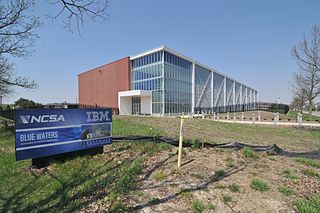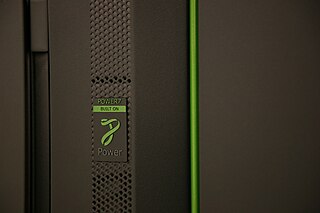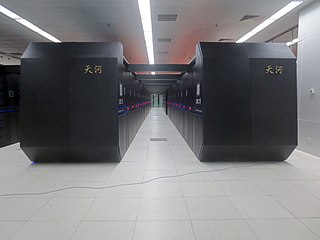Related Research Articles

A supercomputer is a computer with a high level of performance as compared to a general-purpose computer. The performance of a supercomputer is commonly measured in floating-point operations per second (FLOPS) instead of million instructions per second (MIPS). Since 2017, there have existed supercomputers which can perform over 1017 FLOPS (a hundred quadrillion FLOPS, 100 petaFLOPS or 100 PFLOPS).

In computing, floating point operations per second is a measure of computer performance, useful in fields of scientific computations that require floating-point calculations. For such cases, it is a more accurate measure than measuring instructions per second.
Cray Inc., a subsidiary of Hewlett Packard Enterprise, is an American supercomputer manufacturer headquartered in Seattle, Washington. It also manufactures systems for data storage and analytics. Several Cray supercomputer systems are listed in the TOP500, which ranks the most powerful supercomputers in the world.

TeraGrid was an e-Science grid computing infrastructure combining resources at eleven partner sites. The project started in 2001 and operated from 2004 through 2011.

The National Energy Research Scientific Computing Center (NERSC), is a high performance computing (supercomputer) user facility operated by Lawrence Berkeley National Laboratory for the United States Department of Energy Office of Science. As the mission computing center for the Office of Science, NERSC houses high performance computing and data systems used by 7,000 scientists at national laboratories and universities around the country. NERSC's newest and largest supercomputer is Cori, which was ranked 5th on the TOP500 list of world's fastest supercomputers in November 2016. NERSC is located at the main Berkeley Lab campus in Berkeley, California.
The Oak Ridge Leadership Computing Facility (OLCF), formerly the National Leadership Computing Facility, is a designated user facility operated by Oak Ridge National Laboratory and the Department of Energy. It contains several supercomputers, the largest of which is an IBM OLCF-4 named Summit, which was ranked 1st on the TOP500 list of world's fastest supercomputers as of June 2018. It is located in Oak Ridge, Tennessee.

The TOP500 project ranks and details the 500 most powerful non-distributed computer systems in the world. The project was started in 1993 and publishes an updated list of the supercomputers twice a year. The first of these updates always coincides with the International Supercomputing Conference in June, and the second is presented at the ACM/IEEE Supercomputing Conference in November. The project aims to provide a reliable basis for tracking and detecting trends in high-performance computing and bases rankings on HPL, a portable implementation of the high-performance LINPACK benchmark written in Fortran for distributed-memory computers.
High Productivity Computing Systems (HPCS) is a DARPA project for developing a new generation of economically viable high productivity computing systems for national security and industry in the 2002–10 timeframe.

Blue Waters was a petascale supercomputer operated by the National Center for Supercomputing Applications (NCSA) at the University of Illinois at Urbana-Champaign. On August 8, 2007, the National Science Board approved a resolution which authorized the National Science Foundation to fund "the acquisition and deployment of the world's most powerful leadership-class supercomputer." The NSF awarded $208 million for the Blue Waters project.

PERCS is IBM's answer to DARPA's High Productivity Computing Systems (HPCS) initiative. The program resulted in commercial development and deployment of the Power 775, a supercomputer design with extremely high performance ratios in fabric and memory bandwidth, as well as very high performance density and power efficiency.
The National Center for Computational Sciences (NCCS) is a United States Department of Energy (DOE) Leadership Computing Facility that houses the Oak Ridge Leadership Computing Facility (OLCF), a DOE Office of Science User Facility charged with helping researchers solve challenging scientific problems of global interest with a combination of leading high-performance computing (HPC) resources and international expertise in scientific computing.

Jaguar or OLCF-2 was a petascale supercomputer built by Cray at Oak Ridge National Laboratory (ORNL) in Oak Ridge, Tennessee. The massively parallel Jaguar had a peak performance of just over 1,750 teraFLOPS. It had 224,256 x86-based AMD Opteron processor cores, and operated with a version of Linux called the Cray Linux Environment. Jaguar was a Cray XT5 system, a development from the Cray XT4 supercomputer.
Exascale computing refers to computing systems capable of calculating at least "1018 IEEE 754 Double Precision (64-bit) operations (multiplications and/or additions) per second (exaFLOP)"; it is a measure of supercomputer performance.
This list compares various amounts of computing power in instructions per second organized by order of magnitude in FLOPS.

The K computer – named for the Japanese word/numeral "kei" (京), meaning 10 quadrillion (1016) – was a supercomputer manufactured by Fujitsu, installed at the Riken Advanced Institute for Computational Science campus in Kobe, Hyōgo Prefecture, Japan. The K computer was based on a distributed memory architecture with over 80,000 compute nodes. It was used for a variety of applications, including climate research, disaster prevention and medical research. The K computer's operating system was based on the Linux kernel, with additional drivers designed to make use of the computer's hardware.

Titan or OLCF-3 was a supercomputer built by Cray at Oak Ridge National Laboratory for use in a variety of science projects. Titan was an upgrade of Jaguar, a previous supercomputer at Oak Ridge, that uses graphics processing units (GPUs) in addition to conventional central processing units (CPUs). Titan was the first such hybrid to perform over 10 petaFLOPS. The upgrade began in October 2011, commenced stability testing in October 2012 and it became available to researchers in early 2013. The initial cost of the upgrade was US$60 million, funded primarily by the United States Department of Energy.

Tianhe-2 or TH-2 is a 33.86-petaflops supercomputer located in the National Supercomputer Center in Guangzhou, China. It was developed by a team of 1,300 scientists and engineers.

Summit or OLCF-4 is a supercomputer developed by IBM for use at Oak Ridge Leadership Computing Facility (OLCF), a facility at the Oak Ridge National Laboratory, capable of 200 petaFLOPS thus making it the 4th fastest supercomputer in the world after Frontier (OLCF-5), Fugaku, and LUMI. It held the number 1 position from November 2018 to June 2020. Its current LINPACK benchmark is clocked at 148.6 petaFLOPS.
The HPCGbenchmark is a supercomputing benchmark test proposed by Michael Heroux from Sandia National Laboratories, and Jack Dongarra and Piotr Luszczek from the University of Tennessee. It is intended to model the data access patterns of real-world applications such as sparse matrix calculations, thus testing the effect of limitations of the memory subsystem and internal interconnect of the supercomputer on its computing performance. Because it is internally I/O bound, HPCG testing generally achieves only a tiny fraction of the peak FLOPS the computer could theoretically deliver.

Hewlett Packard Enterprise Frontier, or OLCF-5, is the world's first exascale supercomputer, hosted at the Oak Ridge Leadership Computing Facility (OLCF) in Tennessee, United States. It is based on the Cray EX and is the successor to Summit (OLCF-4). As of June 2022 Frontier was the world's fastest supercomputer. Frontier achieved an Rmax of 1.102 exaFLOPS. The supercomputer tops the Green500 list for most efficient supercomputer, measured at 62.68 gigaflops/watt.
References
- ↑ The agencies are the Defense Advanced Research Projects Agency (DARPA), Department of Energy (DOE) Office of Science, National Nuclear Security Administration (NNSA), National Security Agency (NSA), National Science Foundation (NSF), and the National Aeronautics and Space Administration (NASA). See Dongarra et al., p. 8.
- 1 2 3 4 5 Bamford, James (March 15, 2012). "The NSA Is Building the Country's Biggest Spy Center (Watch What You Say)". Wired . Retrieved 6 July 2014.
- ↑ Dongarra, Jack; Graybill, Robert; Harrod, William; Lucas, Robert; Lusk, Ewing; Luszczek, Piotr; McMahon, Janice; Snavely, Allan; Vetter, Jeffery; Yelick, Katherine; Alam, Sadaf; Campbell, Roy; Carrington, Laura; Chen, Tzu-Yi; Khalili, Omid; Meredith, Jeremy; Tikir, Mustafa (2008). "DARPA's HPCS Program: History, Models, Tools, Languages". Advances in Computers. 72: 1–100. doi:10.1016/S0065-2458(08)00001-6. ISBN 9780123744111. Archived from the original on 2018-09-05.
- ↑ "A Secure Facility for New Technologies". Oak Ridge National Laboratory . Retrieved 6 July 2014.
